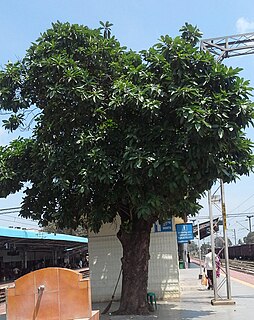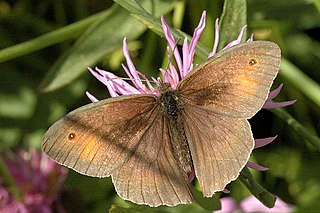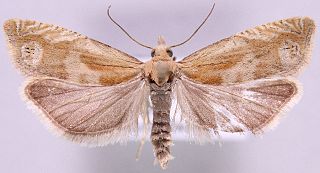
Cota tinctoria, the golden marguerite, yellow chamomile, or oxeye chamomile, is a species of perennial flowering plant in the sunflower family. Other common names include "dyer's chamomile", "Boston daisy", "Paris daisy". In horticulture this plant is still widely referred to by its synonym Anthemis tinctoria.

Morinda tinctoria, commonly known as aal or Indian mulberry, is a species of flowering plant in the family Rubiaceae, native to southern Asia.

Plains coreopsis, garden tickseed, golden tickseed, or calliopsis, Coreopsis tinctoria, is an annual forb. The plant is common to Canada, northeast Mexico, and much of the United States, especially the Great Plains and Southern states where it is often called "calliopsis." The species is also widely cultivated in and naturalized in China.

Indigofera tinctoria, also called true indigo, is a species of plant from the bean family that was one of the original sources of indigo dye. It has been naturalized to tropical and temperate Asia, as well as parts of Africa, but its native habitat is unknown since it has been in cultivation worldwide for many centuries. Today most dye is synthetic, but natural dye from I. tinctoria is still available, marketed as natural coloring where it is known as tarum in Indonesia and nila in Malaysia. In Iran and areas of the former Soviet Union it is known as basma. The plant is also widely grown as a soil-improving groundcover.

Ficus tinctoria, also known as dye fig, or humped fig is a hemiepiphytic tree of genus Ficus. It is also one of the species known as strangler fig.

Yanal Bog is a 1.6 hectare biological Site of Special Scientific Interest on the southern edge of the North Somerset Levels, just north of the village of Sandford, North Somerset. It was notified as an SSSI in 1988.

Plaster's Green Meadows is a 4.3 hectare biological Site of Special Scientific Interest near the village of Nempnett Thrubwell, Bath and North East Somerset, notified in 1989.

Briarcroft Pasture is a 1.76 hectare biological Site of Special Scientific Interest in Cleveland, England notified in 2004.

West Yatton Down is a 14.4 hectare biological Site of Special Scientific Interest in Wiltshire, notified in 1971.

Whitevine Meadows is a 13.0 hectare biological Site of Special Scientific Interest east of North and South Perrott in Somerset, notified in 1979.
NVC community H5 is one of the heath communities in the British National Vegetation Classification system. It is one of three communities which are considered transitional between the lowland dry heaths and the wetter communities classified in the NVC as mires.

Genista tinctoria is a species of flowering plant of the family Fabaceae. Its other common names include dyer's whin, waxen woad and waxen wood.

Monkspath Meadow is a 1.2 ha ancient hay-meadow and a biological site of Special Scientific Interest in the West Midlands. The site was notified in 1986 under the Wildlife and Countryside Act 1981. It is on the south-eastern edge of Monkspath. The site has recently been targeted for development for houses but these plans have been met with uproar from locals in Monkspath and nearby villages, such as Cheswick Green and Hockley Heath, as it would destroy such a special natural site.
S. tinctoria may refer to:

Wrightia tinctoria, Pala indigo plant or dyer’s oleander, is a flowering plant species in the genus Wrightia found in India, southeast Asia and Australia. It is found in dry and moist regions in its distribution. Various parts of the plant have medicinal properties.

Rosenannon Downs is a nature reserve in mid Cornwall, England, UK, being designated Rosenannon Bog and Downs Site of Special Scientific Interest (SSSI), noted for its biological characteristics. The site supports a wide variety of flora and fauna and includes Bronze Age barrows. Conservation work is carried out on the site by the owners, the Cornwall Wildlife Trust.

The Reddish Buff is a moth of the family Noctuidae. It is found throughout continental Europe and in southern Scandinavia. In Britain it is rare and has protected status, being possibly confined to a single site on the Isle of Wight.

Eucosma hohenwartiana, the bright bell, is a species of moth of the family Tortricidae. It is found in China, Central Asia, North Africa and Europe, where it has been recorded from Sardinia, Sicily, Ireland, Great Britain, Spain, France, Germany, the Benelux, Denmark, Austria, Switzerland, Italy, the Czech Republic, Slovakia, Slovenia, Hungary, Poland, Romania, Bosnia and Herzegovina, Norway, Sweden, Finland, the Baltic region and Russia. The habitat consists of dry open areas and grassland.




















